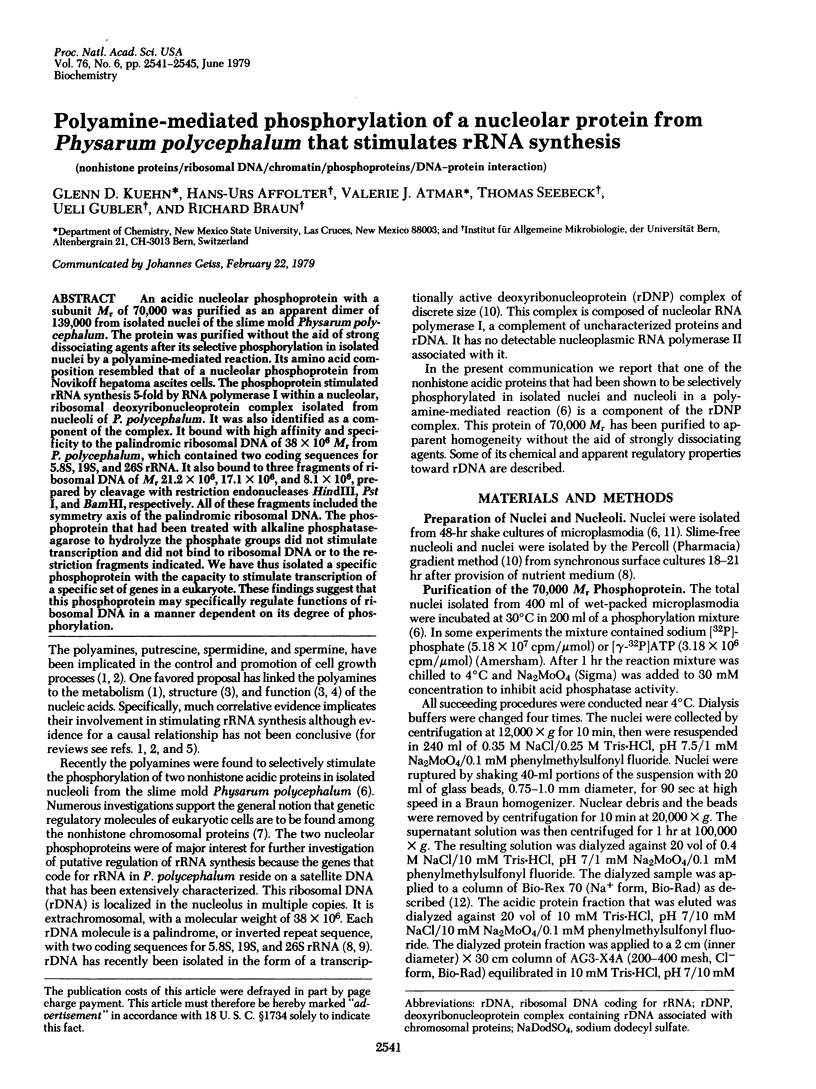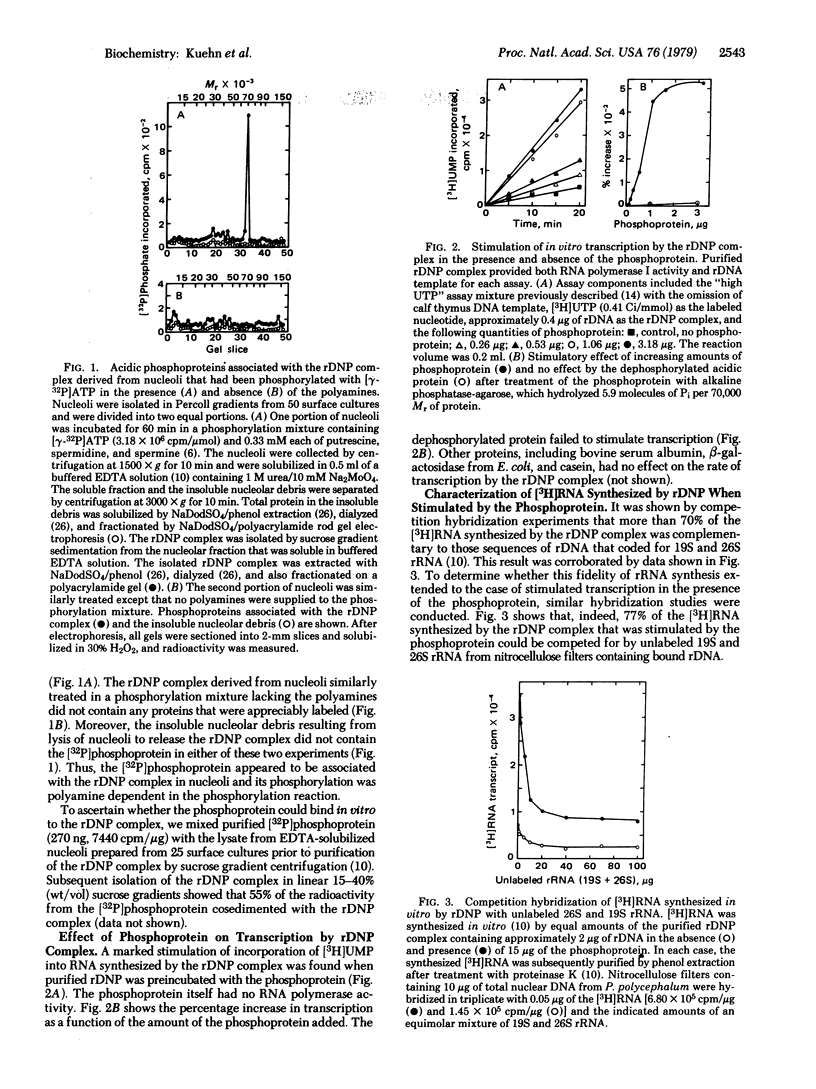Abstract
An acidic nucleolar phosphoprotein with a subunit Mr of 70,000 was purified as an apparent dimer of 139,000 from isolated nuclei of the slime mold Physarum polycephalum. The protein was purified without the aid of strong dissociating agents after its selective phosphorylation in isolated nuclei by a polyamine-mediated reaction. Its amino acid composition resembled that of a nucleolar phosphoprotein from Novikoff hepatoma ascites cells. The phosphoprotein stimulated rRNA synthesis 5-fold by RNA polymerase I within a nucleolar, ribosomal deoxyribonucleoprotein complex isolated from nucleoli of P. polycephalum. It was also identified as a component of the complex. It bound with high affinity and specificity to the palindromic ribosomal DNA of 38 × 106Mr from P. polycephalum, which contained two coding sequences for 5.8S, 19S, and 26S rRNA. It also bound to three fragments of ribosomal DNA of Mr 21.2 × 106, 17.1 × 106, and 8.1 × 106, prepared by cleavage with restriction endonucleases HindIII, PstI, and BamHI, respectively. All of these fragments included the symmetry axis of the palindromic ribosomal DNA. The phosphoprotein that had been treated with alkaline phosphataseagarose to hydrolyze the phosphate groups did not stimulate transcription and did not bind to ribosomal DNA or to the restriction fragments indicated. We have thus isolated a specific phosphoprotein with the capacity to stimulate transcription of a specific set of genes in a eukaryote. These findings suggest that this phosphoprotein may specifically regulate functions of ribosomal DNA in a manner dependent on its degree of phosphorylation.
Keywords: nonhistone proteins, ribosomal DNA, chromatin, phosphoproteins, DNA—protein interaction
Full text
PDF




Selected References
These references are in PubMed. This may not be the complete list of references from this article.
- Andrews P. Estimation of the molecular weights of proteins by Sephadex gel-filtration. Biochem J. 1964 May;91(2):222–233. doi: 10.1042/bj0910222. [DOI] [PMC free article] [PubMed] [Google Scholar]
- Atmar V. J., Daniels G. R., Kuehn G. D. Polyamine stimulation of phosphorylation of nonhistone acidic protein in nuclei and nucleoli from Physarum polycephalum. Eur J Biochem. 1978 Sep 15;90(1):29–37. doi: 10.1111/j.1432-1033.1978.tb12571.x. [DOI] [PubMed] [Google Scholar]
- Brunette M. G., Vigneault N., Danan G. A new fluorometric method for determination of picomoles of inorganic phosphorus. application to the renal tubular fluid. Anal Biochem. 1978 May;86(1):229–237. doi: 10.1016/0003-2697(78)90338-x. [DOI] [PubMed] [Google Scholar]
- Hall L., Braun R. The organisation of genes for transfer RNA and ribosomal RNA in amoebae and plasmodia of Physarum polycephalum. Eur J Biochem. 1977 Jun 1;76(1):165–174. doi: 10.1111/j.1432-1033.1977.tb11582.x. [DOI] [PubMed] [Google Scholar]
- Hall L., Turnock G. Synthesis of ribosomal RNA during the mitotic cycle on the slime mould Physarum polycephalum. Eur J Biochem. 1976 Mar 1;62(3):471–477. doi: 10.1111/j.1432-1033.1976.tb10180.x. [DOI] [PubMed] [Google Scholar]
- James G. T., Yeoman L. C., Matsui S. i., Goldberg A. H., Busch H. Isolation and characterization of nonhistone chromosomal protein C-14 which stimulates RNA synthesis. Biochemistry. 1977 May 31;16(11):2384–2389. doi: 10.1021/bi00630a012. [DOI] [PubMed] [Google Scholar]
- Jänne J., Pösö H., Raina A. Polyamines in rapid growth and cancer. Biochim Biophys Acta. 1978 Apr 6;473(3-4):241–293. doi: 10.1016/0304-419x(78)90015-x. [DOI] [PubMed] [Google Scholar]
- Karpetsky T. P., Hieter P. A., Frank J. J., Levy C. C. Polyamines, ribonucleases, and the stability of RNA. Mol Cell Biochem. 1977 Sep 9;17(2):89–99. doi: 10.1007/BF01743432. [DOI] [PubMed] [Google Scholar]
- Kostraba N. C., Montagna R. A., Wang T. Y. Study of the loosely bound non-histone chromatin proteins. Stimulation of deoxyribonucleic acid-templated ribonucleic acid synthesis by a specific deoxyribonucleic acid-binding phosphoprotein fraction. J Biol Chem. 1975 Feb 25;250(4):1548–1555. [PubMed] [Google Scholar]
- Laemmli U. K. Cleavage of structural proteins during the assembly of the head of bacteriophage T4. Nature. 1970 Aug 15;227(5259):680–685. doi: 10.1038/227680a0. [DOI] [PubMed] [Google Scholar]
- Maniatis T., Jeffrey A., Kleid D. G. Nucleotide sequence of the rightward operator of phage lambda. Proc Natl Acad Sci U S A. 1975 Mar;72(3):1184–1188. doi: 10.1073/pnas.72.3.1184. [DOI] [PMC free article] [PubMed] [Google Scholar]
- Mohberg J., Rusch H. P. Isolation and DNA content of nuclei of Physarum polycephalum. Exp Cell Res. 1971 Jun;66(2):305–316. doi: 10.1016/0014-4827(71)90682-3. [DOI] [PubMed] [Google Scholar]
- Molgaard H. V., Matthews H. R., Bradbury E. M. Organisation of genes for ribosomal RNA in Physarum polycephalum. Eur J Biochem. 1976 Sep 15;68(2):541–549. doi: 10.1111/j.1432-1033.1976.tb10842.x. [DOI] [PubMed] [Google Scholar]
- Penke B., Ferenczi R., Kovács K. A new acid hydrolysis method for determining tryptophan in peptides and proteins. Anal Biochem. 1974 Jul;60(1):45–50. doi: 10.1016/0003-2697(74)90129-8. [DOI] [PubMed] [Google Scholar]
- Quigley G. J., Teeter M. M., Rich A. Structural analysis of spermine and magnesium ion binding to yeast phenylalanine transfer RNA. Proc Natl Acad Sci U S A. 1978 Jan;75(1):64–68. doi: 10.1073/pnas.75.1.64. [DOI] [PMC free article] [PubMed] [Google Scholar]
- Riggs A. D., Suzuki H., Bourgeois S. Lac repressor-operator interaction. I. Equilibrium studies. J Mol Biol. 1970 Feb 28;48(1):67–83. doi: 10.1016/0022-2836(70)90219-6. [DOI] [PubMed] [Google Scholar]
- Sakai T. T., Cohen S. S. Effects of polyamines on the structure and reactivity of tRNA. Prog Nucleic Acid Res Mol Biol. 1976;17:15–42. doi: 10.1016/s0079-6603(08)60064-1. [DOI] [PubMed] [Google Scholar]
- Schaffner W., Weissmann C. A rapid, sensitive, and specific method for the determination of protein in dilute solution. Anal Biochem. 1973 Dec;56(2):502–514. doi: 10.1016/0003-2697(73)90217-0. [DOI] [PubMed] [Google Scholar]
- Seebeck T., Stalder J., Braun R. Isolation of a minichromosome containing the ribosomal genes from Physarum polycephalum. Biochemistry. 1979 Feb 6;18(3):484–490. doi: 10.1021/bi00570a017. [DOI] [PubMed] [Google Scholar]
- Smith S. S., Braun R. A new method for the purification of RNA polymerase II (or B) from the lower eukaryote Physarum polycephalum. The presence of subforms. Eur J Biochem. 1978 Jan 2;82(1):309–320. doi: 10.1111/j.1432-1033.1978.tb12025.x. [DOI] [PubMed] [Google Scholar]
- Tabak H. F., Flavell R. A. A method for the recovery of DNA from agarose gels. Nucleic Acids Res. 1978 Jul;5(7):2321–2332. doi: 10.1093/nar/5.7.2321. [DOI] [PMC free article] [PubMed] [Google Scholar]
- Tabor C. W., Tabor H. 1,4-Diaminobutane (putrescine), spermidine, and spermine. Annu Rev Biochem. 1976;45:285–306. doi: 10.1146/annurev.bi.45.070176.001441. [DOI] [PubMed] [Google Scholar]
- Vogt V. M., Braun R. Structure of ribosomal DNA in Physarum polycephalum. J Mol Biol. 1976 Sep 25;106(3):567–587. doi: 10.1016/0022-2836(76)90252-7. [DOI] [PubMed] [Google Scholar]


